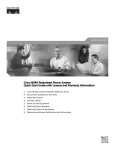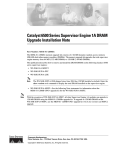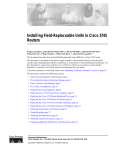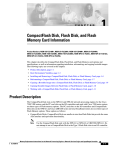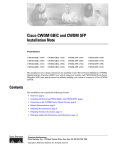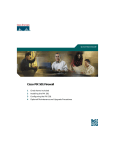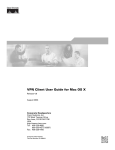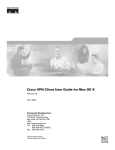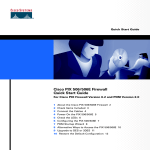Download Cisco CATALYST MEM-C6K-FLC24M Technical information
Transcript
Catalyst 6500 Series Supervisor Engine Flash PC
Card Installation Note
Product Numbers:
MEM-C6K-FLC16M(=)
MEM-C6K-FLC24M(=)
MEM-C6K-FLC64M(=)
MEM-C6K-ATA-1-64M(=)
This installation note contains the procedure to install a Flash PC card in the Catalyst 6500 series
supervisor engines.
Note
The 64-MB ATA Flash PC card (MEM-C6K-ATA-1-64M=) requires Supervisor Engine 2 with
ROMMON software release 7.1(1) or later releases. For ROMMON software upgrade details, refer to
http://www.cisco.com/univercd/cc/td/doc/product/lan/cat6000/relnotes/78_13488.htm.
The ATA Flash PC card is supported on Catalyst 6500 series switches running Cisco IOS Release
12.1(8a)EX or later releases on both the supervisor engine and the Multilayer Switch Feature Card
(MSFC).
The ATA Flash PC card is supported on Catalyst 6500 series switches running Catalyst software
release 7.5(1) or later releases on the supervisor engine and Cisco IOS on the MSFC.
Note
The 64-MB linear Flash PC card (MEM-C6K-FLC64M=) is supported only on Supervisor Engine 1 and
requires ROMMON software release 5.3(1) or later releases.
The 64-MB linear Flash PC card is supported on Catalyst 6500 series switches running Cisco IOS
Release 12.1(13)E4 or later releases on both the supervisor engine and the MSFC.
The 64-MB linear Flash PC card is supported on Catalyst 6500 series switches running Catalyst software
release 7.5(1) or later releases on the supervisor engine and Cisco IOS software on the MSFC.
Corporate Headquarters:
Cisco Systems, Inc., 170 West Tasman Drive, San Jose, CA 95134-1706 USA
Copyright © 1999–2003 Cisco Systems, Inc. All rights reserved.
Contents
This installation note contains the following sections:
•
Supervisor Engine Flash PC Cards, page 2
•
Preventing Electrostatic Discharge Damage, page 3
•
Installing and Removing a Flash PC Card, page 3
•
Using Flash PC Cards, page 6
•
Additional Documentation, page 8
•
Obtaining Documentation, page 8
•
Obtaining Technical Assistance, page 9
Supervisor Engine Flash PC Cards
The supervisor engine Flash PC cards conform with the PCMCIA format. These models are available:
Note
•
16-MB MEM-C6K-FLC16M(=)
•
24-MB MEM-C6K-FLC24M(=)
•
64-MB MEM-C6K-FLC64M(=)
•
MEM-C6K-ATA-1-64M=
The 16-MB MEM-C6K-FLC16M(=) and 24-MB MEM-C6K-FLC24M(=) linear Flash PC cards are
formatted for the Catalyst 6500 series supervisor engines and are ready to use.
The MEM-C6K-ATA-1-64M= and 64-MB MEM-C6K-FLC64M(=) Flash PC cards are not formatted. You
must format these cards (see on page 7 for a description of the format command). When you enter the dir
disk0: or dir slot0: commands, an unformatted Flash PC card returns a “bad device block info” or “invalid
magic number” error message.
Note
Supervisor Engine 1 and Supervisor Engine 2 do not support the same Flash PC card format. To use a
Flash PC card with Supervisor Engine 2, you must format the card with Supervisor Engine 2. To use a
Flash PC card with Supervisor Engine 1, you must format the card with Supervisor Engine 1.
You can use Flash PC cards to store and boot software images or they can be used as servers to store
software images for other systems. You can configure each supervisor engine with one Flash PC card in
slot 0. Figure 1 shows the front panel of a supervisor engine with the single PCMCIA slot, slot 0.
2
78-6507-05 Rev. B0
Figure 1
Supervisor Engine Flash PC Card Slot
Console port
Switch load
display
PCMCIA LED
LINK LEDs
WS-X6K-SUP1
SUPERVISOR I
Status LEDs
Console port mode
switch
PCMCIA slot
16057
PORT 2
K
EJECT
LIN
1%
PORT 1
PCMCIA
K
CONSOLE
Load
LIN
ST
AT
U
S
SY
ST
EM
AC
TIV
E
PW
R
M
G
R
M
ES
T
ET
Switch
CONSOLE 100%
PORT
MODE
1000BASE-X GBIC Uplink Ports
Reset button
For information on using the PCMCIA Flash PC cards, see the “Using Flash PC Cards” section on
page 6.
Preventing Electrostatic Discharge Damage
Follow these guidelines to prevent electrostatic discharge (ESD) damage:
Caution
•
Always use an ESD wrist or ankle strap and ensure that it makes good skin contact.
•
Connect the equipment end of the strap to the ESD connector on the switch.
•
Place a removed Flash PC card on an antistatic surface or in a static shielding bag. If the card will
be returned to the factory, immediately place it in a static shielding bag.
•
Avoid contact between the card and clothing. The wrist strap only protects the card from ESD
voltages on the body; ESD voltages on clothing can still cause damage.
For safety, periodically check the resistance value of the antistatic strap. The measurement should be
between 1 and 10 megohms.
Installing and Removing a Flash PC Card
Before you install a Flash PC card, verify that the card’s write-protect switch is off. When the card is
oriented with the printing side up and the edge connector end away from you, the write-protect switch
is located on the front edge of the card, as shown in Figure 2.
Note
78-6507-05 Rev. B0
Not all Flash PC cards have the write-protect switch.
3
Figure 2
Locating the Flash PC Card Write Protection Switch
Flash PC card
shown with write
protection off
H2352
Flash PC card
write protection
Flash PC card
To install and remove a Flash PC card (see Figure 3), perform these steps:
Note
You can insert and remove the Flash PC card with the power on.
Step 1
Connect an ESD-preventive strap to the ESD connector on the switch.
Step 2
Face the front panel of the switch and hold the Flash PC card with the connector end toward the slot, as
shown in Figure 3a.
Step 3
Insert the card into the slot until it completely seats in the connector at the back of the slot and the eject
button pops out toward you, as shown in Figure 3b.
Note
4
The card does not insert all the way inside the slot; a portion of the card remains outside the slot.
Do not attempt to force the card past this point.
Step 4
To eject a Flash PC card, press the ejector button until the card is free of the connector at the back of the
slot, as shown in Figure 3c.
Step 5
Remove the card from the slot and place it in an antistatic bag.
78-6507-05 Rev. B0
Figure 3
Installing and Removing a Flash PC Card
WS-X5530
EM
ST US
SY TAT
S
N
FA
2
PS
1
T
E
100%
SE
TIV
RE
AC
T
1
O
SL
PS
T
0
O
SL
SUPERVISOR ENGINE I I
I
CONSOLE
AUX
Switch
PCMCIA
Load
EJECT
a
WS-X5530
EM
ST US
SY TAT
S
N
FA
T
E
100%
SE
TIV
RE
AC
2
PS
1
PS
T
1
O
SL
T
0
O
SL
SUPERVISOR ENGINE I I
I
CONSOLE
AUX
Switch
PCMCIA
Load
EJECT
b
WS-X5530
EM
ST US
SY TAT
S
N
FA
2
PS
1
T
E
TIV
AC
100%
SE
RE
SUPERVISOR ENGINE I I
I
T
1
O
SL
PS
T
0
O
SL
CONSOLE
AUX
Switch
Load
PCMCIA
EJECT
14233
c
78-6507-05 Rev. B0
5
Using Flash PC Cards
Note
An MS-DOS formatted ATA Flash PC card or linear Flash PC card can be accessed successfully
(including the dir command) with the Catalyst and IOS operating systems but will not boot from
ROMMON.
Note
The 16-MB MEM-C6K-FLC16M(=) and 24-MB MEM-C6K-FLC24M(=) linear Flash PC cards are
formatted for the Catalyst 6500 series supervisor engines and are ready to use.
The MEM-C6K-ATA-1-64M= and 64-MB MEM-C6K-FLC64M(=) Flash PC cards are not formatted. You
must format these cards (see on page 7 for a description of the format command). When you enter the dir
disk0: or dir slot0: commands, an unformatted Flash PC card returns a “bad device block info” or “invalid
magic number” error message.
Note
Supervisor Engine 1 and Supervisor Engine 2 do not support the same Flash PC card format. To use a
Flash PC card with Supervisor Engine 2, you must format the card with Supervisor Engine 2. To use a
Flash PC card with Supervisor Engine 1, you must format the card with Supervisor Engine 1.
Table 1 shows many of the commands that are available for using and managing Flash devices, including
the Flash PC cards. To perform specific tasks, use these commands either alone or combined with other
commands. For example, to copy a file from a TFTP server to a Flash PC card, set the BOOT
environment variable so that the system will boot from this new image and then verify the boot sequence
as shown in the following steps:
Note
The following commands listed in are not applicable to the ATA Flash (disk0:) PC card: undelete,
squeeze, show flash devices, show flash, and verify.
Note
The ATA Flash PC card is accessed through disk0: and the 16M, 24M, and 64M Flash PC cards are
accessed through slot0:. The following procedure uses slot0:.
Step 1
Copy a file from a TFTP server to the Flash PC card in slot0:
Console (enable) copy tftp slot0:
Step 2
Set the BOOT environment variable so that the system boots from slot0:
Console (enable) set boot system flash slot0:cat6000-sup-5-1-1-CSX.bin prepend
Step 3
Display the contents of the BOOT environment variable:
Console (enable) show boot
For complete descriptions of these commands and how to use them, refer to the Catalyst 6500 Series
Software Configuration Guide and the Catalyst 6500 Series Command Reference publication.
6
78-6507-05 Rev. B0
Table 1
Commands for Using and Managing Flash Devices
Task
Command
Copy a Flash file to a TFTP server, another
Flash device, or to the running
configuration.
copy m/device:filename {tftp | flash | m/device:filename |
config}
Copy a file from a TFTP server to a Flash
device or to the running configuration.
copy tftp {flash | m/device:filename | config}
Copy a file from Flash memory to a TFTP
server or to a Flash device, or to the
running configuration.
copy flash {tftp | m/device:filename | config}
Copy the running configuration to another
Flash device or to a TFTP server.
copy config {flash | m/device:filename | tftp}
Set the BOOT environment variable.
set boot system flash device:[filename] [prepend]
[mod_num]
Format a Flash PC device.
format [spare spare-number] [m/]device1: [[device2:]
[monlib-filename]]
Specify the boot field in the configuration
register, which determines the boot
method the switch will use at the next
startup.
set boot config-register boot {rommon | bootflash |
system} [mod_num]
Display the contents of the BOOT
environment variable.
show boot [mod_num]
Clear a specific image from the BOOT
environment variable.
clear boot system flash device:[filename] [mod_num]
Clear the entire BOOT environment
variable.
clear boot system all [mod_num]
Display a list of files on a Flash device.
dir [[m/]device:][filename] [all | deleted | long]]
Set the default Flash device for the system. cd [[m/][bootflash: | slot0:]]
78-6507-05 Rev. B0
Verify the default Flash device for the
system.
pwd [mod_num]
Delete a file on a Flash device.
delete [[m/]device:]filename
Undelete a file on a Flash device.
undelete index [[m/]device:]
Permanently remove all deleted files on a
Flash device.
squeeze [m/]device:
Identify the supported Flash devices on the
system.
show flash devices
Display information about the Flash PC.
show flash [[m/]device:] [all | chips | filesys]
Verify the checksum of a file on a Flash
device.
verify [[m/]device:] filename
7
Additional Documentation
Refer to the following documents for additional information on supervisor engine Flash devices:
•
Release Notes for Catalyst 6500 Series and Cisco 7600 Series Internet Router Supervisor
Engine 2 ROMMON
•
Catalyst 6500 Series Software Configuration Guide
•
Catalyst 6500 Series Command Reference
Obtaining Documentation
Cisco provides several ways to obtain documentation, technical assistance, and other technical
resources. These sections explain how to obtain technical information from Cisco Systems.
Cisco.com
You can access the most current Cisco documentation on the World Wide Web at this URL:
http://www.cisco.com/univercd/home/home.htm
You can access the Cisco website at this URL:
http://www.cisco.com
International Cisco web sites can be accessed from this URL:
http://www.cisco.com/public/countries_languages.shtml
Documentation CD-ROM
Cisco documentation and additional literature are available in a Cisco Documentation CD-ROM
package, which may have shipped with your product. The Documentation CD-ROM is updated monthly
and may be more current than printed documentation. The CD-ROM package is available as a single unit
or through an annual subscription.
Registered Cisco.com users can order the Documentation CD-ROM (product number
DOC-CONDOCCD=) through the online Subscription Store:
http://www.cisco.com/go/subscription
Ordering Documentation
You can find instructions for ordering documentation at this URL:
http://www.cisco.com/univercd/cc/td/doc/es_inpck/pdi.htm
You can order Cisco documentation in these ways:
•
Registered Cisco.com users (Cisco direct customers) can order Cisco product documentation from
the Networking Products MarketPlace:
http://www.cisco.com/en/US/partner/ordering/index.shtml
8
78-6507-05 Rev. B0
•
Registered Cisco.com users can order the Documentation CD-ROM (Customer Order Number
DOC-CONDOCCD=) through the online Subscription Store:
http://www.cisco.com/go/subscription
•
Nonregistered Cisco.com users can order documentation through a local account representative by
calling Cisco Systems Corporate Headquarters (California, U.S.A.) at 408 526-7208 or, elsewhere
in North America, by calling 800 553-NETS (6387).
Documentation Feedback
You can submit comments electronically on Cisco.com. On the Cisco Documentation home page, click
Feedback at the top of the page.
You can e-mail your comments to [email protected].
You can submit your comments by mail by using the response card behind the front cover of your
document or by writing to the following address:
Cisco Systems
Attn: Customer Document Ordering
170 West Tasman Drive
San Jose, CA 95134-9883
We appreciate your comments.
Obtaining Technical Assistance
Cisco provides Cisco.com, which includes the Cisco Technical Assistance Center (TAC) Website, as a
starting point for all technical assistance. Customers and partners can obtain online documentation,
troubleshooting tips, and sample configurations from the Cisco TAC website. Cisco.com registered users
have complete access to the technical support resources on the Cisco TAC website, including TAC tools
and utilities.
Cisco.com
Cisco.com offers a suite of interactive, networked services that let you access Cisco information,
networking solutions, services, programs, and resources at any time, from anywhere in the world.
Cisco.com provides a broad range of features and services to help you with these tasks:
•
Streamline business processes and improve productivity
•
Resolve technical issues with online support
•
Download and test software packages
•
Order Cisco learning materials and merchandise
•
Register for online skill assessment, training, and certification programs
To obtain customized information and service, you can self-register on Cisco.com at this URL:
http://www.cisco.com
78-6507-05 Rev. B0
9
Technical Assistance Center
The Cisco TAC is available to all customers who need technical assistance with a Cisco product,
technology, or solution. Two levels of support are available: the Cisco TAC website and the Cisco TAC
Escalation Center. The avenue of support that you choose depends on the priority of the problem and the
conditions stated in service contracts, when applicable.
We categorize Cisco TAC inquiries according to urgency:
•
Priority level 4 (P4)—You need information or assistance concerning Cisco product capabilities,
product installation, or basic product configuration.
•
Priority level 3 (P3)—Your network performance is degraded. Network functionality is noticeably
impaired, but most business operations continue.
•
Priority level 2 (P2)—Your production network is severely degraded, affecting significant aspects
of business operations. No workaround is available.
•
Priority level 1 (P1)—Your production network is down, and a critical impact to business operations
will occur if service is not restored quickly. No workaround is available.
Cisco TAC Website
You can use the Cisco TAC website to resolve P3 and P4 issues yourself, saving both cost and time. The
site provides around-the-clock access to online tools, knowledge bases, and software. To access the
Cisco TAC website, go to this URL:
http://www.cisco.com/tac
All customers, partners, and resellers who have a valid Cisco service contract have complete access to
the technical support resources on the Cisco TAC website. Some services on the Cisco TAC website
require a Cisco.com login ID and password. If you have a valid service contract but do not have a login
ID or password, go to this URL to register:
http://tools.cisco.com/RPF/register/register.do
If you are a Cisco.com registered user, and you cannot resolve your technical issues by using the Cisco
TAC website, you can open a case online at this URL:
http://www.cisco.com/en/US/support/index.html
If you have Internet access, we recommend that you open P3 and P4 cases through the Cisco TAC
website so that you can describe the situation in your own words and attach any necessary files.
Cisco TAC Escalation Center
The Cisco TAC Escalation Center addresses priority level 1 or priority level 2 issues. These
classifications are assigned when severe network degradation significantly impacts business operations.
When you contact the TAC Escalation Center with a P1 or P2 problem, a Cisco TAC engineer
automatically opens a case.
To obtain a directory of toll-free Cisco TAC telephone numbers for your country, go to this URL:
http://www.cisco.com/warp/public/687/Directory/DirTAC.shtml
Before calling, please check with your network operations center to determine the level of Cisco support
services to which your company is entitled: for example, SMARTnet, SMARTnet Onsite, or Network
Supported Accounts (NSA). When you call the center, please have available your service agreement
number and your product serial number.
10
78-6507-05 Rev. B0
Obtaining Additional Publications and Information
Information about Cisco products, technologies, and network solutions is available from various online
and printed sources.
•
The Cisco Product Catalog describes the networking products offered by Cisco Systems as well as
ordering and customer support services. Access the Cisco Product Catalog at this URL:
http://www.cisco.com/en/US/products/products_catalog_links_launch.html
•
Cisco Press publishes a wide range of networking publications. Cisco suggests these titles for new
and experienced users: Internetworking Terms and Acronyms Dictionary, Internetworking
Technology Handbook, Internetworking Troubleshooting Guide, and the Internetworking Design
Guide. For current Cisco Press titles and other information, go to Cisco Press online at this URL:
http://www.ciscopress.com
•
Packet magazine is the Cisco monthly periodical that provides industry professionals with the latest
information about the field of networking. You can access Packet magazine at this URL:
http://www.cisco.com/en/US/about/ac123/ac114/about_cisco_packet_magazine.html
•
iQ Magazine is the Cisco monthly periodical that provides business leaders and decision makers
with the latest information about the networking industry. You can access iQ Magazine at this URL:
http://business.cisco.com/prod/tree.taf%3fasset_id=44699&public_view=true&kbns=1.html
•
Internet Protocol Journal is a quarterly journal published by Cisco Systems for engineering
professionals involved in the design, development, and operation of public and private internets and
intranets. You can access the Internet Protocol Journal at this URL:
http://www.cisco.com/en/US/about/ac123/ac147/about_cisco_the_internet_protocol_journal.html
•
Training—Cisco offers world-class networking training, with current offerings in network training
listed at this URL:
http://www.cisco.com/en/US/learning/le31/learning_recommended_training_list.html
78-6507-05 Rev. B0
11
This document is to be used in conjunction with the Catalyst 6500 Series Software Configuration Guide and the Catalyst 6500 Series Command Reference publications.
CCIP, CCSP, the Cisco Arrow logo, the Cisco Powered Network mark, the Cisco Systems Verified logo, Cisco Unity, Follow Me Browsing, FormShare, iQ Breakthrough, iQ
FastTrack, the iQ Logo, iQ Net Readiness Scorecard, Networking Academy, ScriptShare, SMARTnet, TransPath, and Voice LAN are trademarks of Cisco Systems, Inc.; Changing
the Way We Work, Live, Play, and Learn, The Fastest Way to Increase Your Internet Quotient, and iQuick Study are service marks of Cisco Systems, Inc.; and Aironet, ASIST,
BPX, Catalyst, CCDA, CCDP, CCIE, CCNA, CCNP, Cisco, the Cisco Certified Internetwork Expert logo, Cisco IOS, the Cisco IOS logo, Cisco Press, Cisco Systems, Cisco
Systems Capital, the Cisco Systems logo, Empowering the Internet Generation, Enterprise/Solver, EtherChannel, EtherSwitch, Fast Step, GigaStack, Internet Quotient, IOS, IP/TV,
iQ Expertise, LightStream, MGX, MICA, the Networkers logo, Network Registrar, Packet, PIX, Post-Routing, Pre-Routing, RateMUX, Registrar, SlideCast, StrataView Plus,
Stratm, SwitchProbe, TeleRouter, and VCO are registered trademarks of Cisco Systems, Inc. and/or its affiliates in the U.S. and certain other countries.
All other trademarks mentioned in this document or Web site are the property of their respective owners. The use of the word partner does not imply a partnership relationship
between Cisco and any other company. (0304R)
Copyright © 1999–2003, Cisco Systems, Inc.
All rights reserved.
12
78-6507-05 Rev. B0












